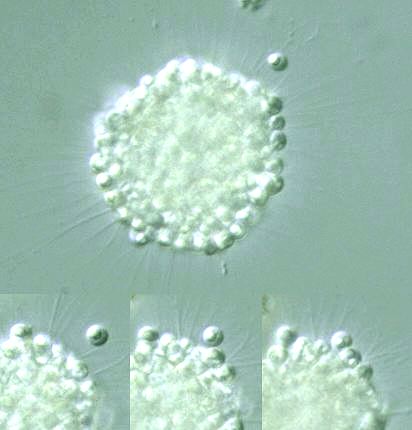
 Diplophrys sp.
Diplophrys sp.
Barker, 1868
 Genus: Test with 2 pseudostomes; with thin, organic test (Illustrated Guide, 1985).
Genus: Test with 2 pseudostomes; with thin, organic test (Illustrated Guide, 1985).
Species:
Colonial or solitary; cell body spherical (8-20 μm in diam.), covered with a delicate hyaline membrane;
two pseudostomes situated at or near two opposite poles; cytoplasm colorless, transparent, finely granular, filling the
envelope (test) except near the two pseudostomes; a single nucleus with a nucleolus;
one large, or two or three small, colored, oil-like globules present;
pseudopodia extremely attenuate, radiating, straight or dichotomously branced, emanating each pseudostome;
reproduction by fission or tetrad division
(Cash, J. (1915) the British Freshwater Rhizopoda and Heliozoa, III, p. 145.)
|
Diplophrys sp.,
a colony (55 μm in diam.) consisting of many cells (6 μm in diam.)
with long pseudopods moves slowly using the pseudopds,
some cells at periphery repeat going out and into the colony,
test μm long,
μm wide,
x 400, x 640, Kurome river, Asaka city, Saitama Pref., Japan, May 2000, by Y. Tsukii
 50 μm
50 μm
 100 μm
100 μm
 150 μm; x 400
150 μm; x 400














Diplophrys archeri Barker:
Colonial or solitary; cell body spherical (8-20 μm in diam.), covered with a delicate hyaline membrane;
two pseudostomes situated at or near two opposite poles; cytoplasm colorless, transparent, finely granular, filling the
envelope (test) except near the two pseudostomes; a single nucleus with a nucleolus;
one large, or two or three small, colored, oil-like globules present;
pseudopodia extremely attenuate, radiating, straight or dichotomously branced, emanating each pseudostome;
reproduction by fission or tetrad division
Young cells frequently aggregated into colonies which form circular masses about 30-60 μm in diam. or more;
from the perphery of which slender pseudopodia radiate;
Cells in a colony about 4 μm in diam., colorless, and transparent except for one dark spot in each
(Cash, J. (1915) the British Freshwater Rhizopoda and Heliozoa, III, p. 145.)
Barker (1868) Qrt. Jrn. Micr. Sci. VIII, p. 123; Barker (1869) Proc. Dubl. Micr. Club, I, 3, p. 178.
Please click on images for viewing enlarged.
Copyright
Protist Information Server
 Genus: Test with 2 pseudostomes; with thin, organic test (Illustrated Guide, 1985).
Genus: Test with 2 pseudostomes; with thin, organic test (Illustrated Guide, 1985).













